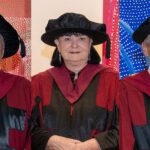Ground-breaking research that may enable greener and safer methods for fabricating materials ranging from drugs to plastics has resulted in two Curtin chemistry researchers being named as finalists in the 2018 Australian Museum Eureka Prizes.
The three-person Invisible Catalyst Team, which includes Dr Simone Ciampi and Dr Nadim Darwish, both ARC DECRA Fellows from Curtin’s School of Molecular Life Sciences, as well as ARC Laureate Fellow Professor Michelle Coote from The Australian National University’s Research School of Chemistry, has been named a finalist for the 2018 UNSW Eureka Prize for Scientific Research.
Dr Darwish said developing new and more efficient ways to catalyse reactions had been an important scientific quest.
“The team has shown that electric fields can be used to manipulate chemical reactions,” Dr Darwish said.
“This breakthrough may change chemical synthesis completely, by enabling the cost-effective production of chemicals and reducing the environmental impact associated with the use of traditional catalysts.
“We believe our research may lead to the fabrication of chemicals and materials that are very difficult to make by conventional methods and our findings also have implications in the fabrication of miniaturised electronics, such as self-healing plastics or molecular diodes and transistors.”
Dr Ciampi said his team had made significant contributions to the understanding of chemical reactivity since 2013, with recent breakthroughs that could change the way synthetic chemistry was done.
“It is through chemical reactions that we grow, eat, reproduce or think, so expanding our capability in manipulating chemical reactions and their outcome is therefore a very important aim,” Dr Ciampi said.
Professor Coote said the team had developed and validated new theories and models for speeding up chemical reactions and demonstrated new rules for chemical reactivity and selectivity by electric fields.
“Up to less than five years ago, it was thought that a catalyst had to be a specific molecule that is engineered for a specific reaction,” Professor Coote said.
“The team has changed this perceived wisdom by showing that for chemical reactions of practical and conceptual value, a specific catalyst, such as a chemical entity, can be replaced by a generic electric field stimulus. This expands our capability of controlling chemical reactions and opens up an exciting realm of possibilities.”
Dr Ciampi is a chemist working in the field of physical chemistry whose research focuses broadly on semiconductor electrochemistry and surface chemistry.
Dr Darwish is at the forefront of nanotechnology research and has established Australia’s first facility for single-molecule electrical microscopy at the Curtin Institute of Functional Molecules and Interfaces.
The winners of the 2018 Australian Museum Eureka Prizes will be announced at an awards ceremony held at Sydney Town Hall on August 29.
The Australian Museum Eureka Prizes, considered Australia’s leading science awards, were established in 1990 to reward outstanding achievements in Australian science and science communication.
For more information about the 2018 Australian Museum Eureka Prizes, visit https://australianmuseum.net.au/eurekaprizes



